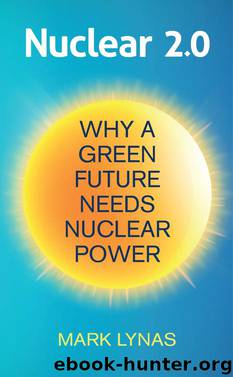Nuclear 2.0 by Mark Lynas

Author:Mark Lynas [Mark Lynas]
Language: eng
Format: epub
ISBN: 9781906860233
Publisher: UIT Cambridge Ltd.
Published: 2014-04-07T04:00:00+00:00
Deaths per terawatt-hour
There is a clear consensus in the scientific literature that, in terms of ‘deaths per terawatt-hour’, other conventional energy sources are more dangerous, by orders of magnitude, than is nuclear power. Oxides of sulphur and nitrogen released during coal combustion cause pulmonary and respiratory diseases, while particulates such as PM2.5 and PM10 from oil and coal are associated with congestive heart failure and cancers as well as bronchitis and asthma. Coal plants also release mercury and other toxins that can accumulate in the food chain. All told, according to the latest Global Burden of Disease study, ambient air pollution worldwide kills 3.2 million people per year.20 The only serious debate in numbers terms is whether the death toll from coal is five hundred times worse than that from nuclear, or many thousands of times worse.
In a landmark 2013 paper, climatologists James Hansen and Pushker Kharecha calculated that the use of nuclear power between 1971 and 2009 avoided the premature deaths of 1.84 million people thanks to its air pollution benefits.21 Ironically, 117,000 of those lives saved were in Germany, thanks to the clean operation of its 17 reactors (commissioned between 1975 and 1989) – and yet the Green Party rose to prominence during that same period primarily to demand the total elimination of nuclear power. Looking to the future, Hansen and Kharecha calculate that nuclear might prevent another 7 million deaths if deployed at large scale and in order to replace coal.
These figures ignore the potential lives saved by nuclear power because of its displacement of CO2 emissions and consequent mitigation of climate change. Hansen and Kharecha do, however, tot up how much CO2 has been saved: a total of about 64 billion tonnes over the last 35 years; equivalent to taking 430 large coal-fired power plants permanently off the grid. (This is about 8 per cent of humanity’s total cumulative CO2 emissions of 817 billion tonnes between 1971 and 2009.) Another 240 billion tonnes could be saved in future, they estimate, substantially increasing our ability to tackle global warming.
Looking at the air pollution mortality figures strongly suggests that it is untrue to say that nobody will die because of Fukushima. People will die, but not from radiation. Their lives will instead be shortened because of an increased reliance on fossil fuels due to post-Fukushima nuclear fear. This is nowhere more the case than in Japan, where after Fukushima every single reactor was closed down, and at the time of writing only two have restarted. Japan’s ‘refossilization’ has led to a massive surge in imports of natural gas and coal, and a consequent 50-million-tonne increase in annual CO2 emissions.22 The Japanese government is now proposing to abandon its climate change targets, acknowledging that meeting them will be impossible without nuclear power.23
Renewed nuclear fear has also led to nuclear exit plans in Belgium, Switzerland and the Netherlands, and even historically pro-nuclear France seems likely to reduce its proportion of nuclear-generated electricity from 80 per cent to 50 per cent thanks to a pre-election deal between President Hollande and the Greens.
Download
This site does not store any files on its server. We only index and link to content provided by other sites. Please contact the content providers to delete copyright contents if any and email us, we'll remove relevant links or contents immediately.
| Automotive | Engineering |
| Transportation |
Whiskies Galore by Ian Buxton(41525)
Introduction to Aircraft Design (Cambridge Aerospace Series) by John P. Fielding(32885)
Small Unmanned Fixed-wing Aircraft Design by Andrew J. Keane Andras Sobester James P. Scanlan & András Sóbester & James P. Scanlan(32569)
Craft Beer for the Homebrewer by Michael Agnew(17928)
Turbulence by E. J. Noyes(7694)
The Complete Stick Figure Physics Tutorials by Allen Sarah(7135)
Kaplan MCAT General Chemistry Review by Kaplan(6590)
The Thirst by Nesbo Jo(6432)
Bad Blood by John Carreyrou(6271)
Modelling of Convective Heat and Mass Transfer in Rotating Flows by Igor V. Shevchuk(6219)
Learning SQL by Alan Beaulieu(6029)
Weapons of Math Destruction by Cathy O'Neil(5824)
Man-made Catastrophes and Risk Information Concealment by Dmitry Chernov & Didier Sornette(5643)
Digital Minimalism by Cal Newport;(5388)
Life 3.0: Being Human in the Age of Artificial Intelligence by Tegmark Max(5182)
iGen by Jean M. Twenge(5158)
Secrets of Antigravity Propulsion: Tesla, UFOs, and Classified Aerospace Technology by Ph.D. Paul A. Laviolette(4974)
Design of Trajectory Optimization Approach for Space Maneuver Vehicle Skip Entry Problems by Runqi Chai & Al Savvaris & Antonios Tsourdos & Senchun Chai(4837)
Electronic Devices & Circuits by Jacob Millman & Christos C. Halkias(4741)
